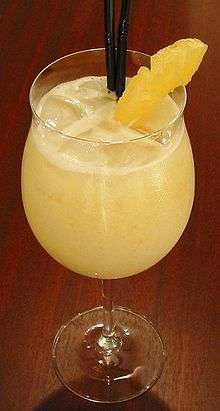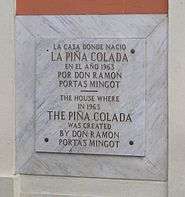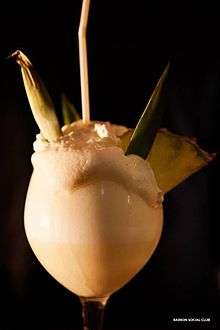Piña colada
| IBA official cocktail | |
|---|---|
 | |
| Type | Mixed drink |
| Primary alcohol by volume | |
| Served | Blended |
| Standard garnish | Pineapple slice and/or maraschino cherry |
| Standard drinkware | Poco |
| IBA specified ingredients |
|
| Preparation | Mix with crushed ice in blender until smooth. Pour into chilled glass, garnish and serve. |
| Notes | Alternately, the three main components can simply be added to a cocktail glass, and then add ice cubes. |
|
| |
The piña colada (/ˌpiːnjə
Origin
The name piña colada literally means "strained pineapple", a reference to the freshly pressed and strained pineapple juice used in the drink's preparation.

Two bartenders from Puerto Rico won a contest for the ownership of their national drink. Stevie Craig Walker claims to have first made it at the Caribe Hilton Hotel's Beachcomber Bar in San Juan in 1954, using Don Q Gold rum and the then newly-available coco lópez cream of coconut. Coco lópez was developed in Puerto Rico in 1948 by Don Ramón López-Irizarry, hence the Puerto Rican connection and the 1952 account of the drink's creation. Some say the drink did not acquire its name until the 1960s.
The Caribe Hilton Hotel sits on a 17-acre (7-hectare) peninsula outside San Juan and was the first luxury hotel to open in the region, becoming a popular destination for the rich and famous who helped spread word of the drink.
Ramón Portas Mingot also says he created it in 1963 at the Barrachina Restaurant, 104 Fortaleza Street, Old San Juan. The restaurant stands by his claim to this day.
National Piña Colada Day is celebrated on the islands on 10 July.
History of the drink
The earliest known story states that in the 19th century, Puerto Rican pirate Roberto Cofresí, to boost his crew's morale, gave them a beverage or cocktail that contained coconut, pineapple and white rum.[4] This was what would be later known as the famous piña colada. With his death in 1825, the recipe for the piña colada was lost.
Ramón "Monchito" Marrero claims to have created the Piña Colada in 1954, when a bartender at the Caribe Hilton. After three months of experimentation, Mr. Marrero finally settled upon the recipe for the Piña Colada, which he felt captured the true nature and essence of Puerto Rico. He continued to serve the drink at the Caribe Hilton for 35 years after its creation and was finally rewarded for his efforts in 1978 when Puerto Rico officially proclaimed the cocktail its national drink.
Caribe Hilton possesses two proclamations that state the hotel is the "Birthplace of the Piña Colada". One proclamation was given by Puerto Rico Governor Sila M. Calderón in 2000, and the other was given in 2014 by Governor Alejandro García Padilla as part of the Piña Colada 60th Anniversary celebrations.
The remodeled Caribe Hilton Bar, Caribar Rums & Light Bites, provides a new menu reflecting the Evolution of the Piña Colada, including a contemporary version: the Clear Colada.
Barrachina, a restaurant in Puerto Rico, also claims to be the birthplace of the piña colada:
In 1963, on a trip to South America, Barrachina met another popular Spaniard and bartender Ramon Portas Mingot. Don Ramon has worked with the best places in Buenos Aires and associated with "Papillon" the most luxurious bar in Carcao and was also recognized for his cocktail recipe books. Pepe Barrachina and Don Ramon developed a great relationship. While working as the main bartender at Barrachina (a restaurant in Puerto Rico), Ramon mixed pineapple juice, coconut cream, condensed milk and ice in a blender, creating a delicious and refreshing drink, known today as the Piña Colada.

In popular culture
This cocktail gained fame in Puerto Rico from 1978, and it gained worldwide fame after Rupert Holmes released his 1979 song "Escape (The Piña Colada Song)", which became a popular hit around the world.
Jazz icon and flugelhorn player Chuck Mangione likewise released a tune titled "Piña Colada" on his 1979 album Fun and Games.
In The Godfather Part II (1974), in the scenes set in Cuba, the characters are offered Piña Coladas several times, even though it is set in 1956 and the drink is said not to have been named as such until at least the 1960s.
The cocktail serves as part of the title of the Garth Brooks song "Two Piña Coladas".
Preparation
There are many recipes of how to make a piña colada but the one that his friends tell in the book of José L. Díaz de Villegas to be the original recipe created by Monchito, is the following:
Pour 85 grams of coconut cream, 170 grams of pineapple juice and 43 grams of white rum into a blender or shaker with crushed ice, and blend or shake very well until smooth. Pour into chilled glass, garnish with pineapple wedge and/or a maraschino cherry.
Variations
Different proportions of the core ingredients, as well as different types of rum, may all be used in the piña colada. Frozen piña coladas are also served. Other named variations include:
- Amaretto colada – amaretto substituted for rum[5]
- Chi chi – with vodka substituted for rum
- Lava Flow – strawberry daiquiri and piña colada blended together[6]
- Virgin piña colada or piñita colada – without the rum, thus non-alcoholic
- Kiwi colada – with kiwifruit (fruit and syrup) in place of pineapple juice
- Soda colada - resembles original recipe but soda is used instead of coconut milk
- Kahlua colada - Substitute Kahlua (coffee liqueur) for rum.
Staten Island Ferry is a cocktail consisting of equal parts Malibu rum and pineapple juice served over ice. In flavor it resembles a Piña Colada (due to the coconut flavor of Malibu rum). As it does not require coconut cream, it is thus more easily prepared in bars that lack the specialty ingredients and blender that a Piña Colada would typically require.
Variants of Blue Hawaii with creme of coconut differ from piña colada mainly by including also blue Curaçao.
See also
References
- ↑ "Piña colada". Merriam-Webster Dictionary. Retrieved 2016-01-21.
- ↑ "piña colada". Oxford Dictionaries. Oxford University Press. Retrieved 2016-01-21.
- ↑ Nuestra piña colada cumple 60 años: Esta bebida nacional ha formado parte de la cultura popular boricua durante seis décadas. Tatiana Pérez Rivera. El Nuevo Dia. 10 August 2014. Retrieved 10 August 2014.
- ↑ "Con diez cañones por banda... y una piña colada en la mano". El Nuevo Diario, EFE. 9 July 2008. Archived from the original on 10 May 2009. Retrieved 11 April 2009.
- ↑ "Frozen/Mixed — Amaretto Colada". Archived from the original on 15 February 2003. Retrieved 20 June 2007.
- ↑ "Lava Flow". Retrieved 20 June 2007.
External links
| Wikimedia Commons has media related to Piña colada. |
| The Wikibook Bartending has a page on the topic of: Piña Colada |